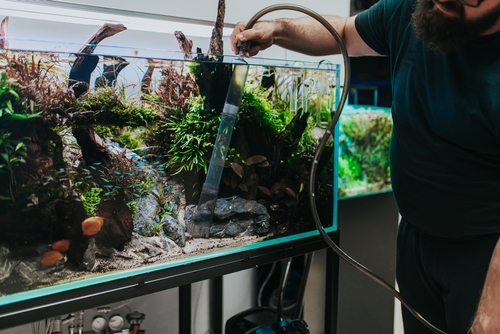Aquarium maintenance is an essential aspect of keeping healthy fish. However, the frequency of aquarium cleaning can be tricky to determine. In this article, we will answer the concern on how often should I clean my fish tank
Cleaning an aquarium entails three goals:
- Controlling nitrate levels
- Maintaining a suitable cleaning frequency
- Preventing wildly swinging water parameters
To accomplish these goals, you will require a few essentials, including a water test kit that measures nitrates and a logbook to record nitrate levels.
The article will also cover the testing methods for nitrates and the determination of water change frequency. Additionally, we will provide tips for handling high nitrate levels and offer long-term solutions for maintaining a healthy aquarium ecosystem.
Contents
Key Takeaways on How Often Should I Clean My Fish Tank?
- Regular testing and recording of nitrate levels are essential for maintaining a healthy aquarium.
- Water changes should be done based on the nitrate levels, aiming to keep them below 40 ppm.
- In the long term, adding live aquarium plants can help reduce nitrate levels and maintain a healthy ecosystem.
Also don’t miss:
- Top 5 Worst Fish For Beginners!
- Best Tips to Keep Your Aquarium Clean!
- 15 Best Freshwater Aquarium Fish
Importance of Cleaning Aquarium

Regular cleaning of an aquarium is vital to maintain a healthy environment for fish to live in. Neglecting to clean an aquarium can lead to the buildup of toxic nitrogen compounds produced by fish waste, which can cause harm to the fish and potentially lead to illness or death.
On the other hand, cleaning an aquarium too frequently with significant water changes can cause stress to the fish and result in the loss of beneficial bacteria.
To determine how often to clean your aquarium, there are three goals to consider. The first goal is to control the nitrate level, which measures the amount of fish waste in the aquarium. The nitrate level should ideally be below 40 parts per million (ppm).
The second goal is to establish a consistent frequency for cleaning the aquarium, such as once a week. The third goal is to prevent wildly swinging water parameters by changing less than 50% of the water, ideally around 25-30%.
Importantly, use a water test kit that measures nitrates and keep a logbook of the nitrate levels each week.
For three to four weeks, measure the nitrate levels and note how much they increase each week. If the nitrate level is above or equal to 40 ppm, perform a 50% water change. If the nitrate level is below 40 ppm, skip the water change for that week.
After three to four weeks, calculate the average amount of nitrates the aquarium produces each week. If the amount is 5 ppm or less, a 25% water change every two weeks is sufficient. If the amount is 10 ppm, a 25% water change every week is recommended.
If the amount is 20 ppm or higher, perform 50% water changes every three to four days until the nitrate level is below 40 ppm. In the long term, options include removing fish, getting a larger aquarium, or introducing live aquarium plants to help consume excess nitrogen.
It is important to remember that an aquarium is a living ecosystem, and any changes to the fish, plants, or feeding habits can affect the nitrate levels. Regular monitoring and adjustment are necessary to maintain a healthy environment for the fish.
Goals for Aquarium Cleaning
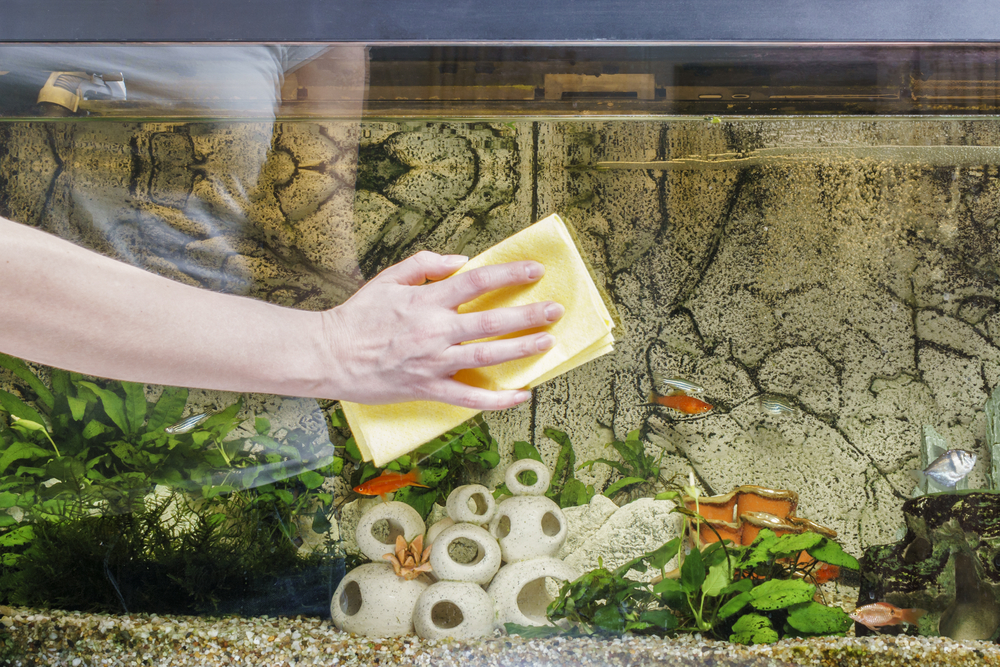
The goals for cleaning an aquarium are to control nitrate levels, determine the frequency of cleaning, and prevent wildly swinging parameters.
Always keep the nitrate levels below 40 ppm, and the frequency of cleaning should not exceed once per week. Water changes should be less than 50% and ideally around 25-30%.
Use a systematic method to determine how often to change the water in an aquarium. The first step is to measure nitrate levels using a water test kit that measures nitrates. A logbook will help record the nitrate levels each week.
If the nitrate level is above or equal to 40 ppm, do a 50% water change. If the nitrate level is below 40 ppm, skip a water change for that week.
Over three to four weeks, the increase in nitrate levels should be recorded. This will give an average amount of nitrates that the aquarium produces each week. If the rise is 5 ppm per week, a 25% water change every two weeks is sufficient.
If the increase is 10 ppm weekly, do a 25% water change every week. If the rise is 20 ppm or more per week, your aquarium is heavily stocked, and you should consider a 50% water change every three to four days until the nitrate levels are below 40 ppm.
In the long term, options include removing some fish from the aquarium, getting a larger aquarium, or adding live aquarium plants. Live plants can help consume excess nitrogen in the aquarium.
It is important to remember that the aquarium is a living ecosystem, and changes in fish or plant populations can affect nitrate levels. Always measure nitrate levels at least once a month to ensure they are on track.
Materials Required for Cleaning
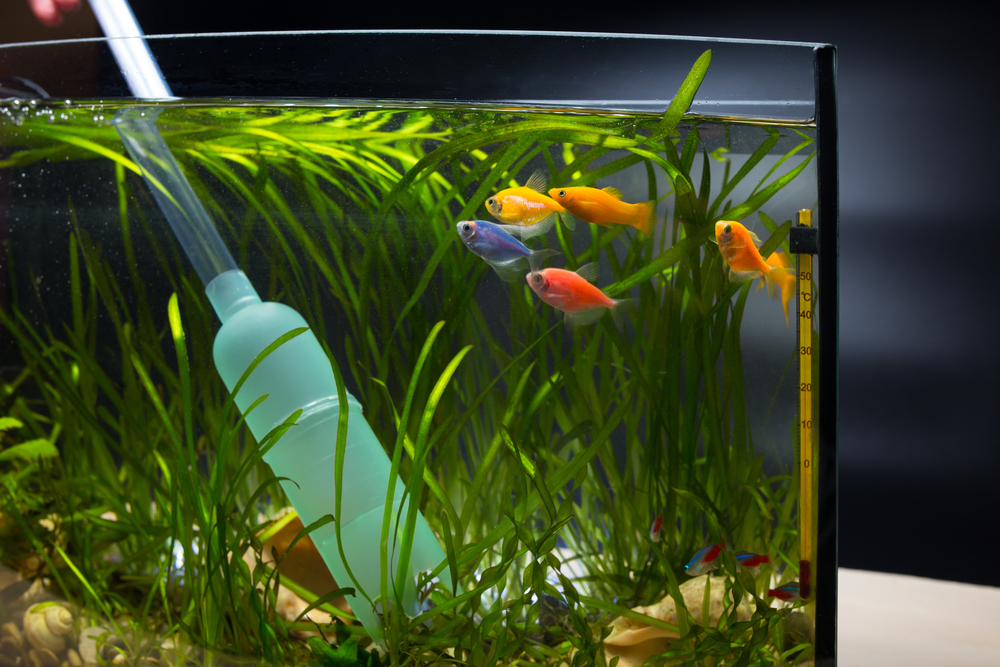
To determine how often an aquarium needs to be cleaned, it is essential to measure the nitrate level. A water test kit that measures nitrates is necessary for this task. Additionally, a logbook or spreadsheet is needed to record the nitrate levels each week.
For regular tank cleaning maintenance, there are two methods for testing nitrates. The first method involves using the API freshwater master test kit, which comes with two bottles and a test tube.
Fill the test tube to the five-milliliter line with aquarium water, and add ten drops of bottle one and bottle two, respectively. Shake the test tube and allow it to rest for five minutes before comparing the color of the liquid to the chart. The ideal nitrate level is below 40 parts per million (ppm).
The second method involves using tetra six-in-one test strips dipped into the water for one second and then left flat for thirty to sixty seconds. The colors that develop are compared to the chart on the label to determine the nitrate level.
Measure the nitrate levels for three to four weeks to determine how often to change the aquarium water. If the nitrate level is above or equal to 40 ppm, a 50% water change is needed.
If the nitrate level is below 40 ppm, you can skip the water change that week. Please also record the increase in nitrate levels each week. At the end of the three to four weeks, calculate the average amount of nitrates the fish tank makes each week.
If the tank makes 5 ppm of nitrates weekly, a 25% water change every two weeks is ideal. If the tank makes 10 ppm of nitrates per week, a 25% water change every week is required.
Conversely, if the tank makes 20 ppm or more of nitrates per week, you must make a 50% water change every week or 50% water change every three to four days until the nitrate level is below 40 ppm.
In the long term, adding live aquarium plants or getting a larger aquarium can help dilute the amount of nitrates in the water. It is important to remember that the aquarium is a living ecosystem, and the number of fish or plants can affect the nitrate levels.
Therefore, always measure the nitrate levels at least once a month to ensure everything is on track.
Testing Methods for Nitrates
To maintain a healthy aquarium, it is vital to control the nitrate level, which measures how much fish waste is in the aquarium. The ideal nitrate level should be below 40 ppm.
To determine how often to change the aquarium water, a systematic method is required. The frequency of water changes should be at most once a week, and the water change should be less than 50% of the total water volume, ideally more like 25 to 30 percent.
To test the nitrate level, a water test kit that measures nitrates is needed. Two methods for testing nitrates are the API freshwater master test kit and the Tetra six-in-one test strips.
For the API water test kit, fill the test tube to the five-milliliter line with water from the aquarium, add ten drops of bottle one and bottle two, shake for one minute, let it rest for five minutes, and compare the color of the liquid to the chart.
For the Tetra six-in-one strips, dip the strip into the water for one second, leave it flat for thirty to sixty seconds, and compare the strip’s colour to the chart.
For three to four weeks, measure the nitrate levels and record them in a logbook. If the nitrate level is above or equal to 40 ppm, perform a 50% water change. If the nitrate level is below 40 ppm, skip the water change for that week.
The most critical column to record is the increase in nitrate level. At the end of the three to four weeks, calculate the average increase in nitrate level per week. If the rise is five ppm, perform a 25% water change every two weeks.
If the increase is 10 ppm, perform a 25% water change every week. If the rise is 20 ppm or higher, perform a 50% water change every week or 50% water changes every three to four days until the nitrate level is below 40 ppm.
In the long term, options to control the nitrate level include removing some fish from the aquarium, getting a bigger aquarium, or adding live aquarium plants. Live aquarium plants can consume nitrogen and help maintain a healthy nitrate level.
It is important to remember that the aquarium is a living ecosystem, and any changes in fish, plants, or feeding habits can affect the nitrate level. Therefore, measure the nitrate levels at least once a month to ensure everything is on track.
Weekly Nitrate Measurement
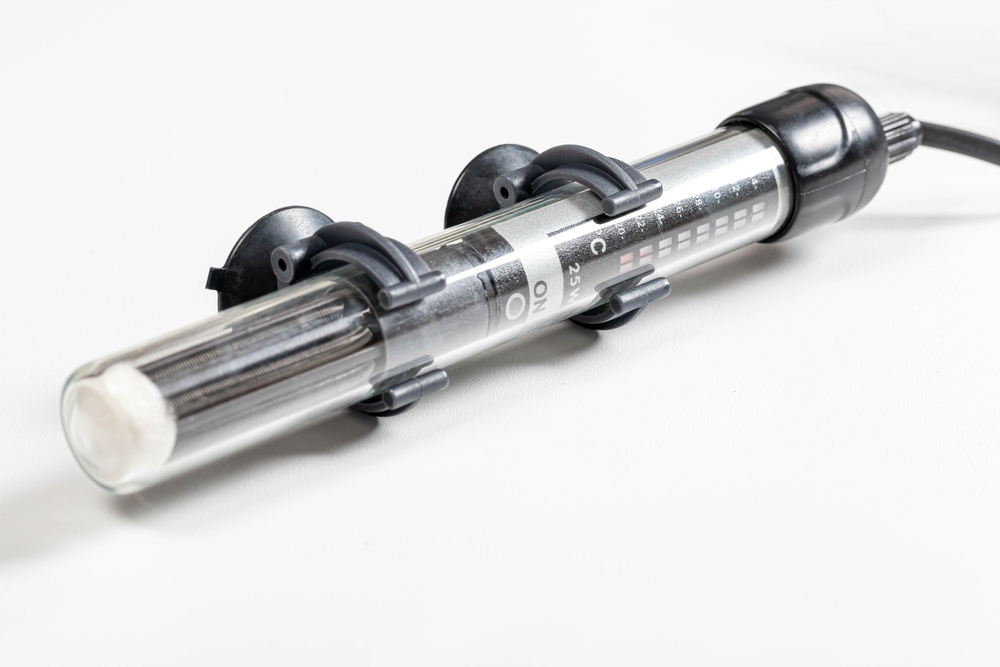
Nitrates are one of the toxic nitrogen compounds produced by fish waste, and their accumulation can cause harm to the fish. The recommended nitrate level is below 40 ppm (parts per million).
To determine how often to change the aquarium water, a systematic method is required. The frequency of water changes should be such that the nitrate level remains below the recommended level and the water parameters do not fluctuate wildly. Changing less than 50% of the water is ideal, with 25-30% being the preferred amount.
To implement this method, a water test kit that measures nitrates and a logbook are required. Measure the nitrate l
weekly for three to four weeks.
If the nitrate level is equal to or above 40 ppm, a 50% water change is required. If the nitrate level is below 40 ppm, skip the water change can that week.
The increase in nitrate levels each week is the most crucial column to track. At the end of the three to four weeks, you can calculate the average amount of nitrate produced by the aquarium each week.
If the nitrate level increases by 5 ppm each week, a 25% water change every two weeks is sufficient. If the nitrate level increases by 10 ppm each week, a 25% water change every week is required.
If the aquarium produces 20-40 ppm of nitrates per week, it is heavily stocked, and temporary measures are necessary. 50% water changes every three to four days should be done until the nitrate level is below 40 ppm. If multiple water changes do not reduce the nitrate level, decrease the feedings to every other day.
In the long term, options include removing some fish, getting a larger aquarium, or adding live aquarium plants. Live plants can consume nitrogen, reducing the nitrate level in the aquarium. It is essential to re-measure nitrate levels at least once a month to ensure everything is on track.
Determining Water Change Frequency
It is important to consider three goals when determining the frequency of water changes for an aquarium. The first goal is to control the nitrate level in the aquarium. Nitrate is a toxic nitrogen compound produced by fish waste, and the aim is to keep the nitrate level below 40 parts per million (ppm).
The second goal is to establish a frequency for water changes that is convenient and manageable. The speaker prefers to change the water once a week. The third goal is to prevent wildly swinging water parameters, which can stress the fish and cause illness.
To determine the appropriate frequency for water changes, the aquarium owner needs a water test kit that measures nitrates and a logbook to record test results. The speaker recommends testing the nitrate level for three to four weeks and recording the results in the logbook.
If the nitrate level is above or equal to 40 ppm, the aquarium owner should perform a 50 percent water change. If the nitrate level is below 40 ppm, the owner can skip the water change for that week.
After three to four weeks, the aquarium owner should calculate the average increase in nitrate levels per week. If the increase is 5 ppm or less, the owner can perform a 25 percent water change every two weeks. If the increase is 10 ppm, the owner should perform a 25 percent water change every week.
If the increase is 20 ppm or more, the aquarium is heavily stocked, and the owner should perform a 50 percent water change every three to four days until the nitrate level is below 40 ppm. If multiple water changes do not reduce the nitrate level, the owner should decrease the amount of food given to the fish.
In the long term, the aquarium owner has several options to control nitrate levels. They can remove some of the fish from the aquarium, get a larger aquarium to dilute the nitrate level, or add live aquarium plants.
Live plants can consume excess nitrogen and help maintain a healthy balance in the aquarium. The aquarium owner should also retest nitrate levels at least once a month to ensure the aquarium is healthy and balanced.
Handling High Nitrate Levels
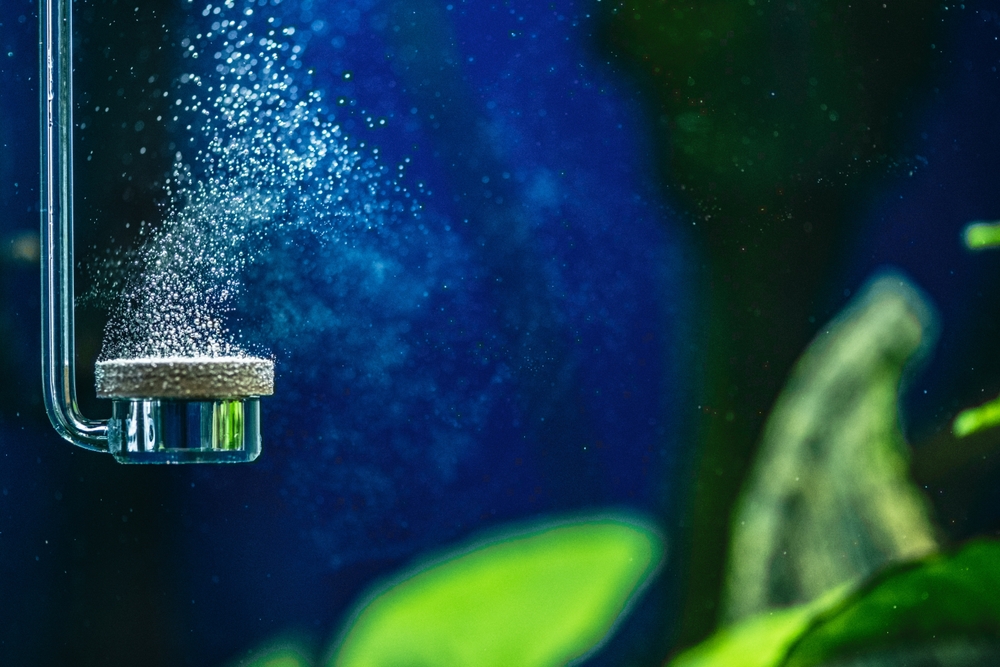
It’s vital to know when to clean your aquarium to maintain a healthy aquarium. Cleaning too frequently can cause stress to fish and loss of beneficial bacteria, while not cleaning enough can lead to high nitrate levels, which can be toxic to fish.
The goal is to control the nitrate level, have a regular cleaning schedule, and prevent wildly swinging water parameters.
To determine how often to change the aquarium water, measure the nitrate levels using a water test kit that measures nitrates and a logbook to keep track of the measurements. The optimal nitrate level is below 40 ppm.
If the nitrate level is above or equal to 40 ppm, a 50% water change is recommended. If the nitrate level is below 40 ppm, skip the water change that week.
For three to four weeks, measure the nitrate levels each week and record the increase. The increase is the most vital column to determine how much the aquarium makes each week. Based on the average increase, you can determine the water change frequency.
If the aquarium makes 5 ppm of nitrates weekly, a 25% water change every two weeks is ideal. If it makes 10 ppm of nitrates weekly, a 25% water change every week is recommended.
If it makes 20 ppm or more of nitrates per week, a 50% water change every week or a 50% water change every three to four days until the nitrate level is below 40 ppm.
If the aquarium is heavily stocked and the nitrate level is consistently high, feeding less or temporarily removing some fish may be necessary. Adding live aquarium plants is also a great option as they consume nitrogen and help maintain a healthy nitrate level.
It is important to remember that the aquarium is a living ecosystem, and any changes made to the fish or plant population can affect the nitrate levels. Therefore, re-measure the nitrate levels at least once a month to ensure everything is on track.
Long-Term Solutions for High Nitrate Levels
The nitrate level should be below 40 ppm, which is one of the toxic nitrogen compounds produced by fish waste. In addition, the frequency of cleaning should be reasonable and reasonable, ideally change less than 50% of the water, and the water parameters should not swing wildly.
To determine how often to change the water, one can use a systematic method. First, measure the nitrate level for three to four weeks with a water test kit that measures nitrates.
If the nitrate level is above or equal to 40 ppm, do a 50% water change. If the nitrate level is below 40 ppm, skip the water change for that week.
The most critical column to track is the increase in nitrate levels each week.
At the end of the three to four weeks, one should have an average amount of nitrates that the fish tank makes each week. If the tank makes 5 ppm of nitrates per week, then a 25% water change every two weeks is sufficient.
If the tank makes 10 ppm of nitrates per week, then a 25% water change every week is necessary.
If the tank makes 20 ppm or more of nitrates per week, a 50% water change every week or 50% water changes every three to four days is necessary.
In the long term, there are several options to reduce nitrate levels. One can remove some fish from the aquarium, get a larger aquarium to dilute nitrate amounts, or get live aquarium plants. Live aquarium plants consume nitrogen and can help reduce nitrate levels.
However, it is essential to remember that the aquarium is a living ecosystem, and changes in fish or plant populations can affect nitrate levels. Therefore, measure nitrate levels at least once a month to ensure everything is on track.
Adjustments for Aquarium Ecosystem
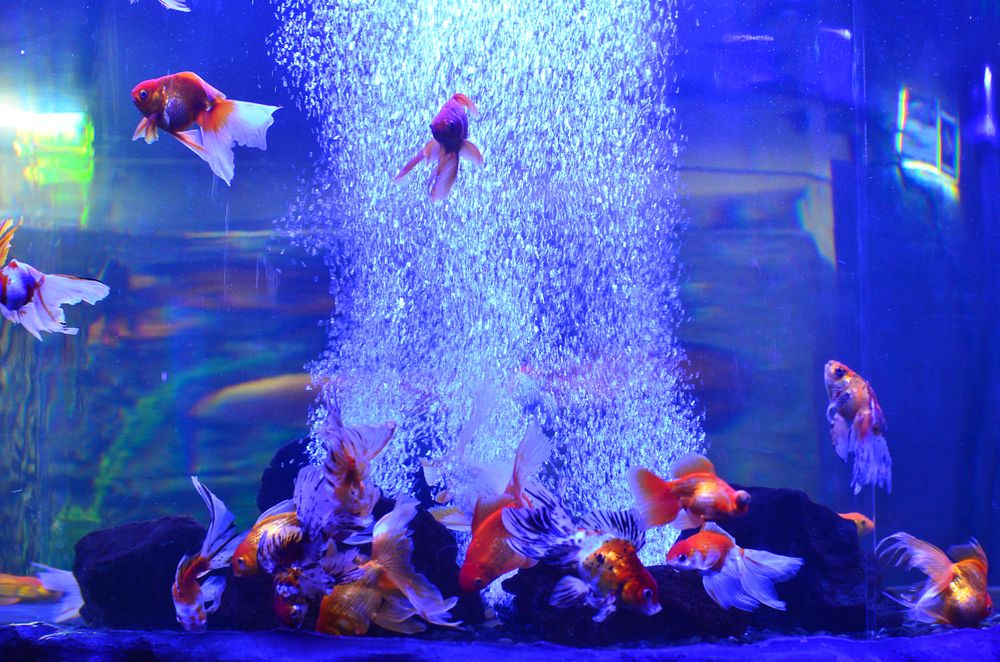
Knowing when to clean an aquarium is crucial to maintaining the health of the fish living in it. Cleaning the aquarium too little can lead to toxic nitrogen compounds produced by fish waste, which can cause fish to get sick and even die.
On the other hand, cleaning the aquarium too much can cause water parameters to swing wildly and lead to the loss of beneficial bacteria, which can also cause fish to get sick.
There are three goals to remember to determine how often to clean your aquarium. The first goal is to control the nitrate level, which measures how much fish waste is in the aquarium. The nitrate level should be below 40 parts per million (ppm).
The second goal is to maintain a cleaning frequency that does not exceed once a week, to avoid stressing the fish. The third goal is to prevent wildly swinging water parameters by changing less than 50% of the water, ideally 25-30% of the water.
A systematic method is recommended to achieve these goals. First, a water test kit that measures nitrates is needed, along with a logbook to record the nitrate levels each week.
Two methods for testing nitrates are provided: the API freshwater master test kit and the Tetra six-in-one test strips.
For three to four weeks, measure the nitrate levels each week. If the nitrate level is above or equal to 40 ppm, a 50% water change is needed. If the nitrate level is below 40 ppm, skip the water change for that week.
The most critical column to note is the increase in nitrate level each week, which should be used to calculate the average amount of nitrates the aquarium produces each week.
If the aquarium is heavily stocked and producing 20-40 ppm of nitrates per week, 50% water changes every three to four days are needed until the nitrate level is below 40 ppm.
If multiple water changes do not lower the nitrate level, decreasing feedings every other day can help reduce fish waste.
In the long term, options include:
- Removing some fish from the aquarium.
- Getting a larger aquarium to dilute the nitrates.
- Adding live aquarium plants to consume the excess nitrogen.
It is important to remember that the aquarium is a living ecosystem, and changes in fish or plant populations can affect nitrate levels. Regularly measuring nitrate levels and adjusting cleaning frequency or adding live plants can help maintain a healthy aquarium ecosystem.
Reminder for Monthly Nitrate Measurement
Aquarium owners need to be mindful of the nitrate levels in their tanks to ensure the health and well-being of their fish. While it’s essential to keep the tank clean, excessive cleaning can cause stress to the fish and lead to the loss of beneficial bacteria.
To maintain a healthy balance, measure the nitrate levels regularly and follow a systematic method to determine how often water changes are necessary.
To control nitrate levels, it’s important to keep them below 40 parts per million (ppm). To achieve this, aquarium owners should measure nitrate levels weekly for three to four weeks using a water test kit that measures nitrates.
If the nitrate level is above or equal to 40 ppm, a 50% water change is recommended. If the nitrate level is below 40 ppm, you can skip a water change that week.
To determine how often to change the water, aquarium owners should keep track of the nitrate levels and calculate the average increase over the three to four weeks. If the nitrate level increases by 5 ppm per week, a 25% water change every two weeks is best.
If the nitrate level increases by 10 ppm per week, a 25% water change every week is recommended. If the nitrate level increases by 20 ppm or more per week, a 50% water change every week or a 25% water change twice a week is recommended.
Aquarium owners should also remember that the nitrate levels can be affected by the number of fish in the tank, the amount of food they are given, and the presence of live aquarium plants.
To maintain a healthy balance, re-measure nitrate levels at least once a month and adjust water changes and feeding accordingly.
In summary, measuring nitrate levels regularly and following a systematic method to determine water changes can help maintain a healthy balance in the aquarium and ensure the well-being of the fish.

Ian Sterling, founder of Fishlab.com, began his aquarium journey over 30 years ago, driven by a deep fascination for fish and their diverse personalities. His website, Fishlab.com, is dedicated to making fishkeeping accessible and enjoyable, offering beginner-friendly guidance, expert insights, and a community for aquarists to connect and share experiences.


